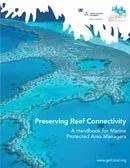 Preserving Reef Connectivity: A Handbook for Marine Protected Area Managers aims to help managers of coastal areas, in particular those of coastal marine protected areas (MPAs), understand and apply the concept of connectivity in their work. Connectivity issues relate to the movement in marine environments of water – and with it sediments, nutrients and pollutants – and of marine organisms. This makes it an important element to consider when contemplating the effective design of MPAs and MPA networks and most other aspects of coastal management.
Preserving Reef Connectivity: A Handbook for Marine Protected Area Managers aims to help managers of coastal areas, in particular those of coastal marine protected areas (MPAs), understand and apply the concept of connectivity in their work. Connectivity issues relate to the movement in marine environments of water – and with it sediments, nutrients and pollutants – and of marine organisms. This makes it an important element to consider when contemplating the effective design of MPAs and MPA networks and most other aspects of coastal management.
Reef areas that support the well-being of over half the world’s population are compromised by management practices that fail to recognize ecosystem interconnections, according to the authors of Connectivity Handbook. A Guide for Marine Protected Area Managers, a practical guide for reef managers published by the Coral Reef Targeted Research & Capacity Building for Management Project (CRTR). The Connectivity Handbook is based largely on the results of research at sites in the Caribbean and Pacific by members of the CRTR’s international Connectivity Working Group.
Printed copies are available from UNU-INWEH, and the Handbook is available for download from both the CRTR (www.gefcoral.org) and UNU-INWEH (www.inweh.unu.edu) sites. A Spanish version is in preparation.
Understanding connectivity patterns is vital for effective reef management. To effectively sustain biodiversity and ecosystem functioning, as well as coastal fisheries, management actions must be designed to ensure that the larvae are able to disperse successfully from spawning sites to the reefs where they will settle and grow. While the authors acknowledge major knowledge gaps, they outline tools and techniques to assess connectivity for coral, fish, lobster and other coral reef species. Although the handbook has been written mainly for coral reef managers, the science discussed is relevant to managers of coastal waters in all oceans.
Some 40% of all people on Earth live within 50 km of a coast, and our enthusiasm for coastal living is creating ever more environmental damage. The decline of coastal environments is a critical problem for many tropical countries with coral reefs. Unfortunately, current management practices in most coastal regions are ineffective, and to continue them endangers coastal economies and ecosystems. Today, climate change is adding to the pressures on coastal ecosystems. This practical handbook is one useful step to help better manage some of the planet’s most critically important resources.
“No-take fishery reserves” and other Marine Protected Areas (MPAs) and are characteristically established without foreknowledge of the connectivity of key species, nor use of techniques for acquiring such information at sites of interest, even though the fundamental importance of such data is broadly recognized. Dispersive pelagic larvae do not drift aimlessly in the ocean. They use their varying behavioral and sensory capabilities to minimize the extent of dispersal, and in many species, are active agents in ensuring successful return to reef habitat, and to specific microhabitats that will be suitable for juvenile life. MPAs should be established in ways that take deliberate advantage of these patterns of use of space. Our relative lack of scientific information on matters such as the correct size, spacing or placement of no-take reserves limits our ability to predict the effects that a proposed no-take reserve will have on surrounding fisheries or biodiversity conservation. The Handbook offers rules of thumb about connectivity that can help estimate patterns of larval dispersal and exchange, noting that some taxa disperse over limited distances, while others disperse more widely. It also demonstrates ways to identify likely patterns of dispersal and track them, and to measure the relatedness of populations of a species across distances.
The Handbook also attempts to answer other questions reef managers commonly struggle with, such as:
- Are MPAs in a network adequately connected?
- What is the maximum geographic distance at which they will remain ecologically connected?
- Are populations within MPAs self-sustaining?
- What is the output of an MPA to surrounding exploited areas?
The authors also urge scientists and managers to work more closely together in an adaptive management context to build and apply new knowledge and insights to decision-making. We have to put in place the best possible local management if we are to provide coral reefs with the capacity to weather global threats. In a world in which climate is changing rapidly, with consequences that are not yet fully apparent, it will be more important than ever to ensure that coral reef and other coastal ecosystems are managed as effectively as possible. Understanding connectivity is an important step to building this effective management.
The Coral Reef Targeted Research & Capacity Building for Management Program (CRTR) is an international development project funded by the Global Environment Facility (GEF), World Bank, and the University of Queensland. CRTR addresses fundamental gaps in understanding of coral reef ecosystems in order to strengthen global management and policies. The Connectivity Working Group, one of six in the project, included 16 leading experts in this technically challenging field, drawn from research and teaching institutions across seven countries, together with collaborators and graduate students.
UNU-INWEH, the United Nations University’s Institute for Water, Environment and Health, which managed the Connectivity Working Group, was established in 1996 to strengthen water management capacity, particularly of developing countries, and to provide on-the-ground project support. With core funding from the Government of Canada through CIDA, it is hosted by McMaster University, Hamilton, Canada.